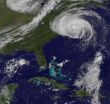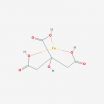(Press-News.org) The modern world -- with its ubiquitous electronic devices and electrical power -- can trace its lineage directly to the discovery, less than two centuries ago, of the link between electricity and magnetism. But while engineers have harnessed electromagnetic forces on a global scale, physicists still struggle to describe the dance between electrons that creates magnetic fields.
Two theoretical physicists from Rice University are reporting initial success in that area in a new paper in the Proceedings of the National Academy of Sciences. Their new conceptual model, which was created to learn more about the quantum quirks of high-temperature superconductors and other high-tech materials, has also proven useful in describing the origins of ferromagnetism -- the everyday "magnetism" of compass needles and refrigerator magnets.
"As a theorist, you strive to have exact solutions, and even though our new model is purely theoretical, it does produce results that match what's observed in the real world," said Rice physicist Qimiao Si, the lead author of the paper. "In that sense, it is reassuring to have designed a model system in which ferromagnetism is allowed."
Ferromagnets are what most people think of as magnets. They're the permanently magnetic materials that keep notes stuck to refrigerators the world over. Scientists have long understood the large-scale workings of ferromagnets, which can be described theoretically from a coarse-grained perspective. But at a deeper, fine-grained level -- down at the scale of atoms and electrons -- the origins of ferromagnetism remain fuzzy.
"When we started on this project, we were aware of the surprising lack of theoretical progress that had been made on metallic ferromagnetism," Si said. "Even a seemingly simple question, like why an everyday refrigerator magnet forms out of electrons that interact with each other, has no rigorous answer."
Si and graduate student Seiji Yamamoto's interest in the foundations of ferromagnetism stemmed from the study of materials that were far from ordinary.
Si's specialty is an area of condensed matter physics that grew out of the discovery more than 20 years ago of high-temperature superconductivity. In 2001, Si offered a new theory to explain the behavior of the class of materials that includes high-temperature superconductors. This class of materials -- known as "quantum correlated matter" -- also includes more than 10 known types of ferromagnetic composites.
Si's 2001 theory and his subsequent work have aimed to explain the experimentally observed behavior of quantum-correlated materials based upon the strangely correlated interplay between electrons that goes on inside them. In particular, he focuses on the correlated electron effect that occur as the materials approach a "quantum critical point," a tipping point that's the quantum equivalent of the abrupt solid-to-liquid change that occurs when ice melts.
The quantum critical point that plays a key role in high-temperature superconductivity is the tipping point that marks a shift to antiferromagnetism, a magnetic state that has markedly different subatomic characteristics from ferromagnetism. Because of the key role in high-temperature superconductivity, most studies in the field have focused on antiferromagnetism. In contrast, ferromagnetism -- the more familiar, everyday form of magnetism -- has received much less attention theoretically in quantum-correlated materials.
"So our initial theoretical question was, 'What would happen, in terms of correlated electron effects, when a ferromagnetic material moves through one of these quantum tipping points?" said Yamamoto, who is now a postdoctoral researcher at the National High Magnetic Field Laboratory in Tallahassee, Fla..
To carry out this thought experiment, Si and Yamamoto created a model system that idealizes what exists in nature. Their jumping off point was a well-studied phenomenon known as the Kondo effect -- which also has its roots in quantum magnetic effects. Based on what they knew of this effect, they created a model of a "Kondo lattice," a fine-grained mesh of electrons that behaved like those that had been observed in Kondo studies of real-world materials.
Si and Yamamoto were able to use the model to provide a rigorous answer about the fine-grained origins of metallic ferromagnetism. Furthermore, the ferromagnetic state that was predicted by the model turned out to have quantum properties that closely resemble those observed experimentally in heavy fermion ferromagnets.
"The model is useful because it allows us to predict how real-world materials might behave under a specific set of circumstances," Yamamoto said. "And, in fact, we have been able to use it to explain experimental observations on heavy fermion metals, including both the antiferromagnets as well as the less well understood ferromagnetic materials."
INFORMATION:
The read the paper's abstract, visit http://www.pnas.org/content/early/2010/08/20/1009498107.abstract
Magnetism's subatomic roots
Rice study of high-tech materials helps explain everyday phenomenon
2010-09-04
ELSE PRESS RELEASES FROM THIS DATE:
MIT moves toward greener chemistry
2010-09-04
CAMBRIDGE, Mass. - Phosphorus, a mineral element found in rocks and bone, is a critical ingredient in fertilizers, pesticides, detergents and other industrial and household chemicals. Once phosphorus is mined from rocks, getting it into these products is hazardous and expensive, and chemists have been trying to streamline the process for decades.
MIT chemistry professor Christopher Cummins and one of his graduate students, Daniel Tofan, have developed a new way to attach phosphorus to organic compounds by first splitting the phosphorus with ultraviolet light. Their method, ...
Moonstruck primates: Owl monkeys need moonlight as much as a biological clock for nocturnal activity
2010-09-04
PHILADELPHIA –- An international collaboration led by a University of Pennsylvania anthropologist has shown that environmental factors, like temperature and light, play as much of a role in the activity of traditionally nocturnal monkeys as the circadian rhythm that regulates periods of sleep and wakefulness.
The study also indicates that when the senses relay information on these environmental factors, it can influence daily activity and, in the case of a particular monkey species, may have even produced evolutionary change. It is possible, according to the study results, ...
NASA imagery reveals a weaker, stretched out Fiona
2010-09-04
NASA satellite data has noticed that Tropical Storm Fiona is getting "longer." That is, the storm is elongating in almost a north-south direction, indicating that she's weakening and may not make it through the weekend. Meanwhile, forecasters are watching two other areas for development in the eastern Atlantic this weekend.
The Geostationary Operational Environmental Satellite, GOES-13 captured an image of Fiona on Friday, Sept. 3 at 10:32 a.m. EDT and the visible image showed a weak circulation in Fiona's center. It also appeared that Fiona's clouds were "stretched" ...
NASA satellite and International Space Station catch Earl weakening
2010-09-04
NASA satellites and the International Space Station are keeping eyes on Hurricane Earl as it heads for New England. Watches and Warnings are posted in the U.S. northeast.
Having felt the effects of both increasing wind shear and cooler waters, Hurricane Earl weakened to a Category 2 storm on the Saffir-Simpson scale with winds still powerful at 90 knots (104 mph) as it neared the North Carolina coast. It was at this time that the Tropical Rainfall Measuring Mission (TRMM) satellite captured the data about TRMM's rainfall rates.
The rainfall pattern associated with ...
Transition metal catalysts could be key to origin of life, scientists report
2010-09-04
MBL, WOODS HOLE, MA—One of the big, unsolved problems in explaining how life arose on Earth is a chicken-and-egg paradox: How could the basic biochemicals—such as amino acids and nucleotides—have arisen before the biological catalysts (proteins or ribozymes) existed to carry out their formation?
In a paper appearing in the current issue of The Biological Bulletin, scientists propose that a third type of catalyst could have jumpstarted metabolism and life itself, deep in hydrothermal ocean vents.
According to the scientists' model, which is experimentally testable, molecular ...
For some women, preventive mastectomies pay off
2010-09-04
SAN ANTONIO, TX (Sept. 3) — A long-term study of women with a genetic predisposition for breast or ovarian cancer showed that those who elected major preventive surgeries had a significantly reduced risk of those cancers.
The study, published Sept. 1 in the Journal of the American Medical Association, confirms the view of one of its researchers, Gail Tomlinson, M.D., Ph.D., interim director of the Greehey Children's Cancer Research Institute at The University of Texas Health Science Center at San Antonio.
Dr. Tomlinson said that for women with certain genetic mutations, ...
Death of the "doughnut"
2010-09-04
Something has been eating Charlie Kerfoot's doughnut, and all fingers point to a European mollusk about the size of a fat lima bean.
No one knew about the doughnut in southern Lake Michigan, much less the mollusk, until Michigan Technological University biologist W. Charles Kerfoot and his research team first saw it in 1998. That's because scientists have always been wary of launching their research vessels on any of the shipwreck-studded Great Lakes in winter. But NASA's new Sea-viewing Wide Field-of-view Sensor (SeaWiFS) Project was giving scientists a safer way to ...
"Back to School" Plastic Surgery Season About to Begin
2010-09-04
Summer is winding down, and Dr. Eric Mariotti (www.drmariotti.com) is now seeing an increase in consultation requests at his Walnut Creek area plastic surgery practice. With kids heading back to school, parents are finding that their schedules are freeing up and many are making more time for their cosmetic goals.
"As a father myself, I understand how busy summers can get for parents," states Dr. Eric Mariotti. "Between watching the kids and working, it can be pretty hard to find time for yourself in the summer months. Early fall is when a lot of people start thinking ...
Galaxie Home Remodeling - Free Installation on Replacement Windows
2010-09-04
As the year end deadline looms for President Obama's American Recovery and Reinvestment Act of 2009, Galaxie Home Remodeling wants every Chicago Area Homeowner to take advantage of this Federal Tax Credit before it expires. As a further incentive to the federal tax credit, Galaxie is now offering free installation on it's replacement windows. The federal program says that qualifying 'Energy saving" purchases made before the end of this year, are eligible for a 30% credit off of the purchase price, up to $1,500.
Galaxie, a full-service home remodeling serving the Greater ...
SurfStream Barreling Wave Machine Debuts in Europe at a Quiksilver and Red Bull Sponsored Event
2010-09-04
American Wave Machines, Inc. (AWM), an innovator in artificial wave technology, today announced that for the first time surfboards with fins have been ridden in a surf machine that includes a barreling standing wave. The machine debuted at the Himlabadet Municipal Aquatic Sports and Spa Facility in Sundsvall, Sweden. The machine is another first for AWM and the locals in Sundsvall turned out in force to ride SurfStream at the opening day event sponsored by Quiksilver and Red Bull.
The event was a successful live demonstration of the newly patented barreling wave technology ...
LAST 30 PRESS RELEASES:
Auburn Physics PhD student earns prestigious DOE Fellowship
AI tool helps you learn how autistic communication works
To show LGBTQ+ support, look beyond Pride Month
Using artificial intelligence to understand how emotions are formed
Exposure to wildfire smoke late in pregnancy may raise autism risk in children
Breaking barriers in lymphatic imaging: Rice’s SynthX Center leads up to $18 million effort for ‘unprecedented resolution and safety’
Dhaval Jadav joins the SETI Institute Board to help spearhead novel science and technology approaches in the search for extraterrestrial life
Political writing retains an important and complex role in the national conversation, new book shows
Weill Cornell Medicine receives funding to develop diagnostic toolbox for lymphatic disease
It started with a cat: How 100 years of quantum weirdness powers today’s tech
McGill researchers identify a range of unexpected chemical contaminants in human milk
Physical therapy research highlights arthritis’ toll on the workforce — and the path forward
Biomedical and life science articles by female researchers spend longer under review
Forgetting in infants can be prevented in mice by blocking their brain’s immune cells
Blocking immune cells in the brain can prevent infant forgetting
AI-driven ultrafast spectrometer-on-a-chip: A revolution in real-time sensing
World enters “era of global water bankruptcy”; UN scientists formally define new post-crisis reality for billions
Innovations in spatial imaging could unlock higher wheat yields
A twitch in time? Quantum collapse models hint at tiny time fluctuations
Community water fluoridation not linked to lower birth weight, large US study finds
Stanford University’s Guosong Hong announced as inaugural recipient of the SPIE Biophotonics Discovery’s Impact of the Year Award
Ice, ice, maybe: There’s always a thin layer of water on ice — or is there?
Machine learning lends a helping ‘hand’ to prosthetics
Noninvasive brain scanning could send signals to paralyzed limbs
Community water fluoridation and birth outcomes
SGLT2 inhibitors vs GLP-1 receptor agonists for kidney outcomes in individuals with type 2 diabetes
Long-term exposure to air pollution and risk and prognosis of motor neuron disease
Five-year absolute risk–based and age-based breast cancer screening in the US
Study finds elevated alcohol involvement in suicides of lesbian, gay and bisexual women
Air pollution may increase the risk of the neurodegenerative disease ALS
[Press-News.org] Magnetism's subatomic rootsRice study of high-tech materials helps explain everyday phenomenon



